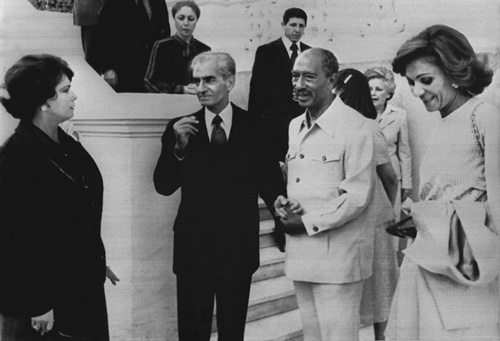Paris
On July 27, 1980, the former Shah of Iran died of cancer while in exile in Cairo, 17 months after being driven out by his country’s Islamic Revolution.
Egyptian president Anwar Sadat, his last remaining ally, laid on a state funeral for the former monarch. Here is an account, based on AFP reports. – Dumped by Iranians, America – The once-venerated Shah Mohammad Reza Pahlavi had fled Iran in January 1979 in the face of an uprising on the streets, after a reign of 37 years in which he dreamt of making his country the fifth world power by 2000.
His exile opened the way for the triumphant return from France on February 1, 1979, of Ayatollah Ruhollah Khomeini and the establishment of an Islamic republic.
At first courted then dumped by the Americans, he drifted between Morocco, the Bahamas, Mexico, the United States and Panama, before being given asylum on March 24, 1980, by his only real ally, Egyptian president Sadat.
Gravely ill on arrival, he was rushed by helicopter to a military hospital, where he had his spleen removed. He then had a long convalescence at Cairo’s Kubbeh Palace, surrounded by his wife, Farah Diba, and four children. But his health deteriorated. Hours after the Shah’s death, Sadat announced “with great sadness” in an address to the nation the loss “of a friend and a brother”. “Let’s leave to history the task of judging Mohammad Reza Pahlavi as a leader, but we, in Muslim Egypt, show recognition and respect for him as a man and as a Muslim,” he said.
AFP reported: “Right up to the last moment, flying in the face of criticism, in the Muslim world and in his own country alike, the Egyptian head of state remained loyal to the one he continued to call ‘the Shah.’” The two men’s staunch friendship dated back to the early 1970s. The Shah stood by Egypt during the Israeli-Arab war of 1973, sending medical aid and doctors, but especially by allowing Soviet planes to fly over Iran to supply Cairo with weapons and military equipment. In Tehran, the former monarch’s death was announced in a laconic statement on national radio. But the Iranian headlines left no doubt the next day. “The vampire of the century is dead,” said the Tehran Times. “The pharaoh is dead,” Pars agency wrote.
Jomhouri-e Eslami, the newspaper of the Islamic Republican Party, accused the United States of having killed the exiled monarch. Official reaction was limited to parliamentary speaker Ayatollah Hashemi Rafsanjani, who described the death as “a small problem, without importance”.
Radical students who had seized 52 hostages at the US embassy in Tehran some nine months earlier, demanding the Shah’s extradition, said they were not interested in getting his body back.
They said the hostages, who went on to be held for 444 days, would only be released once the Shah’s assets were returned.
– 21-gun salute –
The state funeral in Egypt took place on July 29. The anthem of imperial Iran was performed, and Sadat then led a funeral cortege transporting the coffin, draped with the Iranian flag and driven on a gun carriage drawn by six horses, from the presidential palace to the Al-Rifai mosque.
Behind him followed members of the former imperial family, representatives of other deposed royal families, including Greece’s King Constantine, and thousands of Egyptian soldiers.
No sitting head of state made the journey. The United States, France, Britain, Japan, ans Australia sent ambassadors. Under a heavy sky, the funeral cortege travelled for two kilometres (1.2 miles) across popular neighbourhoods of Cairo that usually swarmed with people.
Along with a heavy security presence, some 100,000 people lined the route. On arrival at the mosque, Sadat and the former Shah’s two sons, Reza Cyrus and Ali Reza, accompanied the body to the funeral chamber.—AFP










